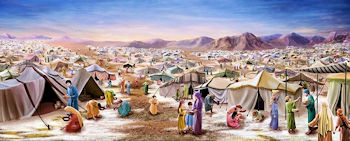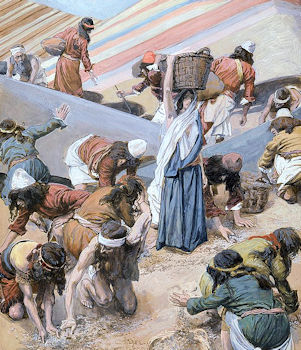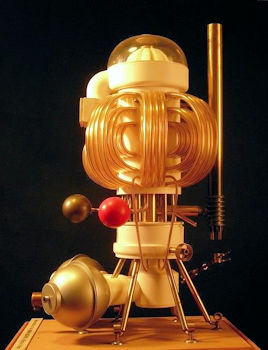The title of this article is a ‘play on words’ because of its redundancy; it is my way of having a little fun. Let me explain. I recently read an article by a woman who reflected upon a story from her early years of marriage. She wrote, “When my husband and I were first married (and I was learning to cook — gulp!), occasionally dinner would turn out less than recognizable. On evenings like this, he would turn to me and say, ‘Manna?’ Because manna in Hebrew means, ‘What is it?’”1
Well, that is exactly what happened when God rained down bread from heaven, while the Israelites were in the wilderness of Sin2 (area in the Sinai Peninsula). This never before seen product befuddled the hundreds of thousands Hebrews and they asked, “What is it?” In Hebrew, they were saying man-hu, which translates as “what is it?” or something similar. So, the question actually became the name of the bread from heaven.3
If you haven’t read the story in the Bible, it can be found in Exodus, chapter 16; the thirty-six verses will only take you a few minutes to read, but it will give you much more information about the event than this article. The Israelites had left Egypt a month and a half previously and they had run out of food. They complained to Moses saying that if they had stayed in Egypt, they may have been slaves, but at least they wouldn’t have died from starvation.
 Moses petitioned God with the problem and the Lord promised to rain bread from heaven to provide for everyone. They were to gather only enough for the people in their household, but no more, and they were to gather two day’s supply prior to the Sabbath, so there would be enough for their day of rest. It they tried to gather more than their share, it would spoil.
Moses petitioned God with the problem and the Lord promised to rain bread from heaven to provide for everyone. They were to gather only enough for the people in their household, but no more, and they were to gather two day’s supply prior to the Sabbath, so there would be enough for their day of rest. It they tried to gather more than their share, it would spoil.
Some of the manna was placed in a golden urn and kept as a memorial, later to be placed in the Ark of the Covenant (Hebrews 9:4). At creation, God rested on the seventh day (Genesis. 2:2), but he did not command man to do so at that time. But, now he gave the law of the Sabbath to the nation of Israel and later it became one of the Ten Commandments (Exodus 20:9-11). It was to be a sign of the covenant made with Israel at Mount Sinai (Exodus 31:13) and a weekly reminder of their deliverance from Egyptian bondage (Deuteronomy 5:15).4
There were occasions when meat was also supplied by God, but you can read about those details yourself, if interested, for this article focuses only upon the manna. And there are two descriptions referring to this heavenly product; the first is in Exodus 16:1-36 and the second in Numbers 11:1-9. So, what can we deduce from those biblical descriptions?
Deductions from the Bible
“And in the morning there was a layer of dew around the camp. When the layer of dew lifted, there on the surface of the wilderness was a fine flaky substance, as fine as frost on the ground,” (Exodus 16:13b-14, NRSV).5
 The grain-like6 manna is described as like seed, very similar to that of the coriander (cilantro) plant.7 After being ground and baked, it resembled sweet wafers. It was white, although some accounts described it as being the same color of Indian myrrh (gray-white). In the Book of Numbers, it states the manna resembled bdellium,8 a tree extraction.9 Numbers also compares the taste of manna with both honey and oil (Numbers 11:8), which may have depended on how it was prepared.10
The grain-like6 manna is described as like seed, very similar to that of the coriander (cilantro) plant.7 After being ground and baked, it resembled sweet wafers. It was white, although some accounts described it as being the same color of Indian myrrh (gray-white). In the Book of Numbers, it states the manna resembled bdellium,8 a tree extraction.9 Numbers also compares the taste of manna with both honey and oil (Numbers 11:8), which may have depended on how it was prepared.10
Another trait of God’s manna is that it was able to change its flavor to the likes of those who ate it. The Hebrew book, Wisdom of Solomon, is used by the Catholic Church, as well as several Protestant churches, and in that book is a beautiful description of the Israelites receiving the manna. In praise to God, a selection from the New Revised Standard Version says the following.
“You gave your people food of angels, and without their toil you supplied them from heaven with bread ready to eat, providing every pleasure and suited to every taste. For your sustenance manifested your sweetness toward your children; and the bread, ministering to the desire of the one who took it, was changed to suit everyone’s liking,” (Wisdom 16:20b-21).
Commentary on manna is not exclusive to the Jewish tradition, for in the New Testament, manna is mentioned in both the Gospel of John and the Book of Revelation. In a sermon, Jesus compares God’s gift of body-nourishing manna to his own ability to deliver spiritual nourishment.11 Our Lord refers to the manna when he calls himself the “true bread from heaven” (John 6:31–35, 48–51), and also the “hidden manna” (Rev. 2:17).
The word manna also appears three times in the Quran (the primary religious text of Islam), at 2:57, 7:160, and 20:8,12 and is recounted in the Sahih Muslim (collection of sayings and deeds of the Prophet) that states Muhammad said: “Truffles [type of fungus] are part of the ‘manna’ which Allah sent to the people of Israel through Moses, and its juice is a medicine for the eye.” This may be in reference to ‘evil eye’ (Arabic: ‘al-‘ayn’) which is a supernatural curse upon others. According to Islamic tradition, it is a very real transmitted infliction which can cause sickness, loss of wealth, or even result in death.13
Other Thoughts
One commentary suggests manna is only a natural phenomenon of the desert and suggests “the tamarisk bush, which grows in parts of the Sinai Peninsula, is infested with scale insects that suck its sap, some of which is excreted in the form of globules that solidify in the sun and fall to the ground. This sticky substance is rich in carbohydrates and sugars and can support the life of a starving wanderer.”14
 A popular encyclopedia adds that the tamarisk manna scale is produced by Trabutina mannipara, a mealybug found in the Middle East. The females produce large quantities of honeydew that solidify in thick layers on plant leaves in arid regions.” This sugar-like material is still collected by natives of Arabia and Iraq and considered a delicacy.15
A popular encyclopedia adds that the tamarisk manna scale is produced by Trabutina mannipara, a mealybug found in the Middle East. The females produce large quantities of honeydew that solidify in thick layers on plant leaves in arid regions.” This sugar-like material is still collected by natives of Arabia and Iraq and considered a delicacy.15
And according to another commentary, by using the Arabic term for manna, it could be derived from aphids “which fits one widespread modern identification of manna, the crystallized honeydew of certain insects. In the environment of a desert, such honeydew rapidly dries due to evaporation of its water content, becoming a sticky solid, and later turning whitish, yellowish, or brownish.”16
This ‘honeydew’, one author says, is a saccharine deposit secreted on the leaves of plants and is sometimes also produced by a fungus.17 And another type of manna is gezhemgen, from an oak in Turkey and Iran. This white substance is created by aphids, and when dried forms white stone-like lumps, which are ground or pounded for use in making breads.18
There seems to be an unending attempt, among some scholars, to find a simple scientific reason to explain what manna is, how it was produced, and how it got to where the Israelites happened to be. Now, I believe God uses his own physical laws — those that he used to produce this universe — to perform his miracles. To me, if some natural occurrence coincides with an event, it may be that God uses it to his own advantage, but that would be a convenience, not a necessity. One day we may learn how God produced that manna, but until then, we can’t just grab at straws to find a solution which is understandable to our lowly human brains.
Along these thoughts, one author stated the idea well. “It says that there were miracles, originating entirely with God, to punish or protect, to destroy or to save . . . It is not that the Bible reflects the state of knowledge in an earlier, pre-scientific culture, and that we who are more enlightened have the capacity to understand the events in the Bible more accurately.”19
“The Bible is not a record of ancient observations; it is a grand theological statement about God’s interaction with humanity and the world. Rationalizing its stories does not ‘explain’ the Bible. Rationalizing, in fact, obscures it. Even if there are various edible substances in the desert, the biblical story of the manna is still a story of divine providence at a time of intense need.”20
The Manna Machine
There is another idea of what manna is, but it is on the fringe of belief. So much so, that one would think it was some odd theory presented by ancient alien believers. While ancient alien theorists may have latched onto the idea, the general thought isn’t modern, but one from an ancient Jewish kabbalah21 source.
That source is the Zohar, which it is a set of twenty-three books providing a commentary on biblical and spiritual matters in the form of conversations amongst ancient spiritual experts. It is mostly written in a cryptic and obscure style of Aramaic. Aramaic was the day-to-day language of Israel in the Second Temple period (539 BC – 70 AD), and was also the original language of large sections of the biblical books of Daniel and Ezra, and is the main language of the Talmud.22
These volumes — once considered secrets to which only a few were granted access — are now considered guidebooks presenting information pertaining to the universe that science is only now beginning to understand.23 This ancient Zohar reports on something called the ‘Ancient of Days’ (or Ancient of Ancients) who provided the manna. Not everyone believes the Ancient of Days is God.
 Author Georgio Tsoukalos, researcher on the Ancient Aliens television series, said, “The text speaks of brains of different sizes, faces of different sizes, which connected with different tubes. And there were different sources of light. When I deal with this from a modern perspective, what is described in the Zohar is not necessarily a divine figure, but rather, a type of machine.”24
Author Georgio Tsoukalos, researcher on the Ancient Aliens television series, said, “The text speaks of brains of different sizes, faces of different sizes, which connected with different tubes. And there were different sources of light. When I deal with this from a modern perspective, what is described in the Zohar is not necessarily a divine figure, but rather, a type of machine.”24
Supposedly, this machine “captured the damp morning air and condensed it on the part of the machine that looks like a dome.” This was then mixed with seaweed and treated with energy to accelerate growth. The energy was produced in a small nuclear reactor that would produce the necessary heat and light. “The manna machine was a very dangerous device; some theorists suspect that the reactor that powered the machine was being transported in the Ark of the Covenant.”25
If the Jews’ survival depended on the manna machine, where did they get it? Some think they stole it from the Egyptians when they left Egypt, but where did the Egyptians get it? Some theorists believe that it would be unlikely to have been built on Earth and suspect that extraterrestrials gave it to them as a charitable gesture to prevent famine in the desert.26
In 1978 someone actually built a machine based upon the description given in the Zohar. This machine, called the ‘Ancient of Days’, was constructed by engineer George Sassoon, who claims it created a food source of algae.27 In his book The Manna Machine (coauthored with Rodney Dale), he said that “a nuclear reactor used to power the manna machine was stored within the Ark of the Covenant. The Ark was supposed to have powered the machine to run continuously, producing manna for six days and on the seventh day the machine would be taken apart for cleaning so it could run the following week.”28
I’m fairly sure not many theologians or similar experts were consulted on this theory, but even if they were, nearly all academics believe that this ‘Ancient of Days’ is a description of God Almighty. The title ‘Ancient of Days’ has been used as a source of inspiration in art and music, for denoting the creator’s aspects of eternity combined with perfection.29
Conclusion
The beginning days in the desert exodus were harsh for the Israelites, being uncomfortable, overwhelming, and scary. And during this time between leaving Egypt and receiving the covenant in Sinai, God and his people tested each other. The Lord was looking to see whether or not the Israelites would trust and obey him, after experiencing all his efforts on their behalf. And the Israelites were attempting to put God in the position of meeting their demands.30
An appropriate song to go with the theme of this discourse is “Manna Form Heaven” by the Contemporary Christian and Southern Gospel group, Gaither Vocal Band.. This song highlights the deep resonant voice of baritone singer Todd Suttles, and his facial expressions display his naturally infectious joy. Selected lyrics are below and the music video link is listed in References & Notes.31

Feed me manna from heaven
Feed me, feed me, Jesus. Feed me till I want no more
Feed me manna from heaven
Feed me, Jesus. You can satisfy the need I’m longing for
In this wilderness we need nothing less
Than Your table spread with our daily bread
Fill our thirsty souls till they overflow
Help us feed a hungry world today…we pray
![]()
Copyright © 2022, Dr. Ray Hermann
OutlawBibleStudent.org
→ Leave comments at the end, after ‘References & Notes’.
Your email address will NOT be published. You can view our basic rules for comments by clicking “The Fine Print” on the top menu bar.
References & Notes
- Motl, April, “What Is Manna and its Significance in Scripture?” (Christianity, Salem Web Network, retrieved 4 February 2022), https://www.christianity.com/wiki/christian-terms/what-is-manna-and-its-significance-in-scripture.html
- Strong’s Hebrew #5512. סִין (Çıŷn), Sin (pronounced: seen); the name of a town and, possibly, the desert area adjoining it.
Strong, James, The New Strong’s Complete Dictionary of Bible Words, (Nashville, TN: Thomas Nelson Publishers, 1996). - Easton, M. G., Illustrated Bible Dictionary and Treasury of Biblical History, Biography, Geography, Doctrine, and Literature, (New York: Thomas Nelson, 1893), p. 443.
- William MacDonald, Believer’s Bible Commentary: Old and New Testaments, (Ed.) Arthur Farstad, (Nashville: Thomas Nelson, 1995), p. 103.
- All scripture is quoted from The Holy Bible: New Revised Standard Version, (Nashville, TN: Thomas Nelson Publishers, 1989). Used with permission.
- Bruce, Barbara J., in Holman Illustrated Bible Dictionary, (Eds.), Chad Brand, et al., (Nashville, TN: Holman Bible Publishers, 2003), p. 1074.
- Cilantro and coriander are of the same plant species: Coriandrum sativum. In North America, cilantro refers to the leaves and stalks of the plant, while the dried seeds are called coriander seeds.
- Bdellium comes from Commiphora africana trees (in Afghanistan, Arabia, Babylon, India, etc.). It consists of a water-soluble gum, resin, and an essential oil. Now it is used in perfumery, incense, and medicine. It is also used as an adulterant of the more costly myrrh.
“Bdellium”, (Wikipedia, Wikimedia Foundation, 23 November 2021), https://en.wikipedia.org/wiki/Bdellium - “Manna, the Mystery Food God Sent Down from Heaven”, (Ancient Code, retrieved 3 February 2022), https://www.ancient-code.com/what-was-manna-the-mystery-food-god-sent-down-from-heaven/
- Cabal, Ted, (Ed.) The Apologetics Study Bible, (Nashville TN: Holman Bible Publishers, 2017), p. 91.
- Eisen, Erica X., “The Very Real Search for the Bible’s Mythical Manna”, (Atlas Obscura, 18 March 2019), https://www.atlasobscura.com/articles/is-manna-real
- Rippin, Andrew; Mojaddedi, Jawid, (Eds.), The Wiley Blackwell Companion to the Quar’an, (Oxford, UK: John Wiley & Sons Ltd, 2017), p. 308.
- “The Evil Eye”, (Learn Islam, retrieved 3 February 2022), https://learn-islam.org/evil-eye-class1
- Mays, James Luther, (Ed.), Harper’s Bible Commentary, (San Francisco: Harper & Row, 1988), p. 147.
- DeLong, Dwight Moore, “homopteran: insect order” in Encyclopædia Britannica, (26 July 1999), https://www.britannica.com/animal/homopteran
- Black, M.; Rowley, H., (Eds.), Peake’s Commentary on the Bible, (Nairobi, Kenya: Thomas Nelson and Sons Ltd., 1992), pp. 224-225.
- Merriam-Webster’s Collegiate Dictionary, 11th ed., (Springfield, MA: Merriam-Webster, Inc., 2003).
- Isin, Mary, Sherbet & Spice: The Complete Story of Turkish Sweets and Deserts, (London: I. B. Tauris & Company Publishers [a Bloomsbury imprint], 2012).
- Baden, Joel S., “The Problem With Rationalizing the Bible”, (Huffpost Religion, The Huffington Post, 4 March 2012), https://www.huffpost.com/entry/rationalizing-the-bible_b_1161610
- Ibid.
- Kabbalah: an esoteric method, discipline, and school of thought in Jewish mysticism.
- “Zohar”, (Wikipedia, Wikimedia Foundation, 21 January 2022), https://en.wikipedia.org/wiki/Zohar
- “What is the Zohar?”, (The Zohar, retrieved 3 February 2022), https://www.zohar.com/
- Thames, Nancy, “Extraterrestrial Manna Machine That Produced Food For Desert People”, (Time for Disclosure, 26 July 2021), https://timefordisclosure.com/extraterrestrial-manna-machine-that-produced-food-for-desert-people/
- Ibid.
- Ibid.
- “The Manna Machine” (Wikipedia, Wikimedia Foundation, 13 July 2021), https://en.wikipedia.org/wiki/The_Manna_Machine
- Ibid.
- “Ancient of Days”, (Wikipedia, Wikimedia Foundation, 5 January 2022), https://en.wikipedia.org/wiki/Ancient_of_Days
- Coover-Cox, Dorian G., in CSB Study Bible: Notes, (Eds.), Edwin Blum, et al., (Nashville TN: Holman Bible Publishers, 2017), p. 115.
- “Manna From Heaven”, Artist: Gaither Vocal Band; Authors: William J. Gaither, Chip Davis; CD/DVD: We Have This Moment; (copyright 2017; licensed to YouTube by Hanna Street Music [BMI], Songs of Rambo McGuire/Fozzyboy Music); used under ‘fair use’ copyright for teaching under Section 107 of Copyright Act of 1976, – MUSIC VIDEO: https://youtu.be/6XPpFAOeM9U


Ray, I would dispute your claim that God did not command man to honour the Sabbath until Sinai. God rested on the 7th day and sanctified it because in it He rested from all the work which he had created and made. Gen 2:3. So this day was very important to God obviously – so why would he wait over a thousand years to tell mankind to remember it and worship on it? Was it somehow not important until Sinai? I don’t think so.
Mankind knew about it’s importance from day 1. Remember in the desert they were told NOT to gather any manna on the sabbath or it would rot and stink? I would say that the day was hugely important and the people knew it and were also reminded of it. Which brings another point: if it were not important to worship God on that day until Sinai, then none of the other commandments came into effect until then either right? And if so, then that means murder, lying, adultery etc were not a sin until the 10 were given at Sinai.
What about Cain killing Abel? Joseph fleeing Potiphars wife? Lamech taking 2 wives? They all knew what they did was wrong (or in Josephs case right), so the 10 commandments were in effect from the first sin of Adam and Eve. It is exemplified all through the OT before Sinai – people have simply not used critical thinking skills to assess the bible.
And in those new days after creation – they were so far above us in intellect and health – they did not need to write it down on paper – their memories were excellent. And they had Adam sharing everything he had learned from communing with the angels and the Trinity. In Isaiah 66:22 It says that all mankind will be keeping the sabbath forever, including in heaven we will be worshipping on the sabbath. Thank you Caroline
Thank you for your excellent comments, and for your opinion on the quote from this article. I welcome feedback, both pro and con.
I agree that “God blessed the seventh day, and sanctified it” (Gen. 2:3, KJV), however scholars have not been successful in tracing the origin of the recurring Sabbath, and history indicates it was unique only to ancient Israel.* “Why would he wait over a thousand years to tell mankind to remember it?” Well, the Bible doesn’t say.
There are some denominations that suggest (or insist) Abraham and other patriarchs must have kept the Sabbath, but just suggesting something isn’t a proof in itself. The Seventh-day Adventist Church is well-known for this belief. While I respect this denomination, because of the amount of truth that they preach, they can’t show, dogmatically, that each repeating seventh day, before the exodus, was a day of rest demanded by God.** Others agree that it wasn’t a law in Genesis. The citation I gave, for the quoted paragraph for my article, was written by a contemporary commentator’*** And here are a couple of other references, from much closer to the time of Christ.
Justin Martyr wrote (150 AD), “Moreover, all those righteous men already mentioned [after mentioning Adam, Abel, Enoch, Lot, Noah, Melchizedek, and Abraham], though they kept no Sabbaths, were pleasing to God.” (‘Dialogue With Trypho, a Jew’, Ante-Nicene Fathers, vol. 1, page 204)
Tertullian wrote (200 AD), “Therefore, since God originated Adam uncircumcised, and inobservant [nonobservant] of the Sabbath, consequently his offspring also, Abel, offering Him sacrifices, uncircumcised and inobservant [nonobservant] of the Sabbath, was by Him commended. . . Noah also, uncircumcised – yes, and inobservant [nonobservant] of the Sabbath – God freed from the deluge. For Enoch, too, most righteous man, uncircumcised and inobservant [nonobservant] of the Sabbath, He translated from this world. . . Melchizedek also, “the priest of most high God,” uncircumcised and inobservant [nonobservant] of the Sabbath, was chosen to the priesthood of God. (‘In Answer to the Jews’, Ante-Nicene Fathers, vol. 3, p. 153)
* “The Sabbath”, (Encyclopedia Britannica, retrieved 10 February 2022), https://www.britannica.com/topic/Judaism/The-Sabbath
** Martin, Ernest L., “Did Abraham Observe the Sabbath?” (Associates for Scriptural Knowledge, April 1975), https://www.askelm.com/doctrine/d100101.htm#_ftn1
*** MacDonald, William, Believer’s Bible Commentary: Old and New Testaments, (Ed.) Arthur Farstad, (Nashville: Thomas Nelson, 1995), p. 103.